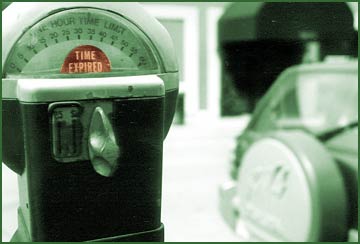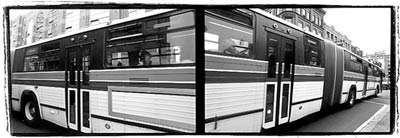Time Expired
By Stephen Leahy

Cars represent freedom, convenience and, of course, road trips. Cars also harm the environment. But new pollution-free vehicles are finally getting the green light. |
Maybe there is such a thing as an honest car salesman after all.
The head of one of the world's largest automobile companies has come clean about the pollution cars spew into the atmosphere. Fujio Cho, president of Toyota, has acknowledged the damage cars cause the planet.
Despite improved emissions controls, cars still pump out tonnes of nasty air pollutants. And this toxic mix includes carbon dioxide, the main 'greenhouse gas' that causes climate change.
That's why Cho says the auto industry must limit its impact on the Earth.
However, the car is not driving off into the sunset anytime soon. The truth is, our modern society loves the car and the freedom and convenience it represents.
But it wasn't love at first sight; few people were originally interested in the motor vehicle. Although the internal combustion engine was patented in the U.S. in the 1840s, it took another 60 years before automobiles became more than a curiosity.
Cars just didn't make sense because of poor roads, the lack of a cheap and plentiful fuel source, and an excellent, well-established railway system. In the late 1800s, railways criss-crossed America, connecting most communities in the same way highways do today.
It was the same story up in the Great White North. In Montreal circa 1890, for example, there were 480 passenger trains arriving or departing from the city every week. Today it's just over 100.
The discovery at the turn of the century of how to refine oil into that high-powered liquid called gasoline opened the door to the automotive age. And Henry Ford's assembly line revolution in 1910 made it possible to crank out cars in high volume and low cost.
Not long after, governments began building roads. Lots of roads.
So began the massive shift from the mass transportation of the previous century to the 'one-person-one-car' trip of today. To speed up the process, auto-manufacturers, oil companies, steel and rubber industrialists, and road construction companies bought local mass transit systems and privately-owned railways. These were then closed or allowed to deteriorate.
In the U.S., General Motors bought more than 100 electric mass transit systems in 45 cities and replaced them with diesel buses. In Canada, expenditures on the nation's transportation infrastructure followed a similar path.

By the end of the 20th century, billions more were being spent on roads by all levels of government in Canada than on urban transit and railways combined. |
There are now over 875,000 kilometres of roads in Canada, and some 14 million cars. On average, every Canadian drives 16,000 km each year. Despite improved emissions controls, each of these cars pump out four tonnes of air pollutants a year, according to Environment Canada.
The toxic by-products of the internal combustion engine include carbon monoxide, ground-level ozone (smog), sulphur oxides, nitrous dioxide and benzene. Fine particulates also spew from the automobile's tailpipe, extremely tiny hazards of less then ten microns in diameter (there are a million microns in a metre).
These particles are the result of incomplete fuel combustion and lodge deep inside the lung, aggravating respiratory illnesses such as asthma, bronchitis and emphysema. "Long term exposure may increase the risk of developing a chronic lung disease," write the authors of Breathable Air in Your Community, a community action guide on air quality published by the Ontario Environment Network.
In Ontario - Canada's air pollution capital - Health Canada estimates that 1,800 premature deaths each year are a direct result of polluted air. Across the country the rates and severity of asthma and other respiratory conditions are climbing.
Motor vehicles are a major source of carbon dioxide emissions, the main 'greenhouse gas' that's causing our biggest environmental headache - climate change.
In Canada, about a quarter of the carbon dioxide produced comes from gasoline and diesel powered vehicles. As the second largest source after the industrial sector, motor vehicles have long been targeted by environmentalists.
That's why Cho, who runs Toyota, the world's third-largest automaker, says the industry has to start building "environmentally friendly cars." It's an honest admission from a business slow to recognize the ecological reality outside their windshields.
Several companies have already launched hybrid electric/gasoline-powered vehicles that dramatically increase fuel efficiency and reduce emissions. Honda has revealed its Insight, while Toyota has produced a car called the Prius.
And Ford has unveiled the Think City car, a two-seater electric vehicle with a body made from recycled plastic.

Most companies are also developing mass-market cars that will run on something called a fuel-cell - the "holy grail" of the automobile industry.
In a nutshell, a fuel cell car is an electric car without batteries. The cell converts a fuel's energy into electricity by harnessing a chemical reaction between hydrogen and oxygen instead of burning fuel. This basic chemical reaction is at least three times more efficient than combustion.
Hydrogen fuel can be obtained from ordinary water, methanol, natural gas and even biomass -compost from municipal or agricultural wastes. It's a new twist on the phrase "fill 'er up." Depending on the source, virtually the only "waste product" a fuel cell spews out is water.
And an emissions-free model could be the light at the end of the car tunnel.
One of the pioneers in this fast-moving industry is a Canadian company, Ballard Power Systems of Burnaby, British Columbia. Ballard has already unveiled the world's first full-sized hydrogen fuel cell transit bus, which has a range of 400 kilometres.
Germany's Daimler Benz (the makers of Mercedes Benz) has road-tested the first commercial fuel cell mini-van, and Ford has unveiled several passenger car prototypes. Both Daimler Benz and Ford use Ballard's fuel cell technology.
Cars using fuel cells would be much lighter since the apparatus itself can weigh as little as 60 kilograms. The cars would also be much quieter, require less maintenance and, with no moving parts, the cell would probably outlast the rest of the vehicle.
When mass-produced, the theory is that the costs will be about the same as for conventional automobiles.
But it will be a while before people can trade in their gas-guzzlers for these new eco-cars. Hydrogen is an extremely flammable gas, and the industry is trying to come up with lightweight tanks that can withstand a crash. And there aren't as yet any stations where you can fill up with hydrogen.
The fuel cell industry did get a boost recently when the U.S. government announced a partnership with automakers to develop fuel cell cars. One of the goals of the partnership is to develop a hydrogen-refuelling infrastructure.
So, despite the obstacles in the road, we could be on the cusp of a new golden age of the automobile - an emission-free form of transportation that uses a renewable fuel source. (Of course these new vehicles will still be made of many non-renewable materials including plastic and aluminium, and the manufacturing processes are unlikely to be emission-free.)
The hydrogen fuel cell could finally make the car a sustainable choice for personal transportation. A pollution-free vehicle may be just down the road.
However, cars - even emission-free cars - are expensive. The Canadian Automobile Association estimates that it costs between $6,000 and $7,000 a year to own and run a vehicle. That's often why a two-car family needs two wage earners: one has to work just to cover the cost of their transportation.
Cars also need roads. And roads, not to mention bridges, interchanges and parking lots, are expensive.
Highways can cost $100 to $200 million a kilometre. It's commonly believed that license and fuel taxes cover these costs, but they only defray half of the expenses. Each year an extra $4.6 billion has to come from general tax revenues to pay for Canada's system of roads and highways.
Then there are the hidden costs of road transportation such as snow removal, traffic control, emergency and police services, not to mention the multibillion dollar costs of traffic accidents. The Worldwatch Institute in Washington D.C. advocates adding a $2 U.S.-per-gallon tax to offset some of the free ride drivers are getting.
Mass transit fares may not recoup full costs either, but public transport remains more cost-efficient than the private automobile. The Regional Municipality of Ottawa-Carleton decided to ask the question in 1995 and found that the local transit system received a public subsidy that was one-quarter of what the automobile system enjoyed.

And transit is still safer, more fuel-efficient and takes up less space.
Cars also have other subtle but far-reaching effects on society. For the past fifty years our villages, towns and cities have been built to accommodate the automobile.
Even 'eco-cars' will jam up city streets, forcing pedestrians and bikers off to the side.
The most obvious example of our car culture is the suburb with its low population densities and segregated zoning. To get anywhere or do anything, a car is required.
Shopping is centralized in distant malls, and increasingly, in even more distant warehouse outlets. There are few jobs in suburbs, so residents must commute 40 or 50 kilometres on average. And 90 percent do so by car because suburban densities and road patterns make it very difficult to adopt mass transit.
Much has been written about the problems of suburban sprawl: the high per capita levels of auto emissions, energy waste and infrastructure costs (roads, sewage and other utilities).
Yet suburbs continue to be built. One reason is that the people who plan our communities don't know of any other way. Another is the general perception that building a dense, diverse community by definition creates a slum.
Europe, however, offers plenty of examples of compact, prosperous communities. One of the most beautiful and liveable cities in Europe is Vienna, Austria, with a density of 29 residents per acre. Typical Canadian suburbia houses 6 to 10 people per acre.
Emission-free cars will not change suburban Canada. Many argue that our real transportation problem is a fixation on meeting basic human needs of food, shelter, jobs and community by increasing our mobility rather than meeting these needs locally. This is the difference between building a new highway that reduces a 45 minute drive to work by 15 minutes or creating local employment that's a 15 minute walk away.
Sue Zielinsky, a writer and sustainable transportation expert in Toronto, says it is helpful to get our minds focused on access - meeting needs locally - rather than mobility. This requires a re- orientation of our transportation priorities from roads to walkways, and from cars to feet.
Zielinsky believes choosing access over mobility would translate into a new transportation hierarchy where travel by foot would be our first option, followed by bicycle, bus, train, taxi, car pooling, the individually-owned car and, finally, the airplane.
We obviously can't walk or bike everywhere, but the merging of travel options - for example, biking or even driving to a transit station for that last leg downtown - will help us exit the transportation gridlock.
In Canada and around the world, there are a growing number of sustainable transportation success stories we can draw inspiration from. Ottawa has built an extensive network of bikepaths to get people to work, and bike and ride programs are so popular in Japan that there are 12-story bike parking garages at train stations. In the Netherlands, civil servants get free transit passes, while in Oxford, England, municipal officials get free bikes.
And the remarkable city of Curitiba, Brazil has become an eco-Mecca for urban planners, transit officials and environmentalists the world over. Seventy-five percent of all city travel is done by transit - the world's highest transit usage. But Curitiba didn't ban cars; it instead made transit cheaper, faster and more enjoyable than driving.
These are just some of the alternative exits Canadian society could take, if we choose to venture off the main highway of conventional transportation policy.
Stephen Leahy is a freelance writer specializing in science, the environment and agriculture.
Written February 2002
| Return to Top
|
| Articles Archive
| About Our Times |